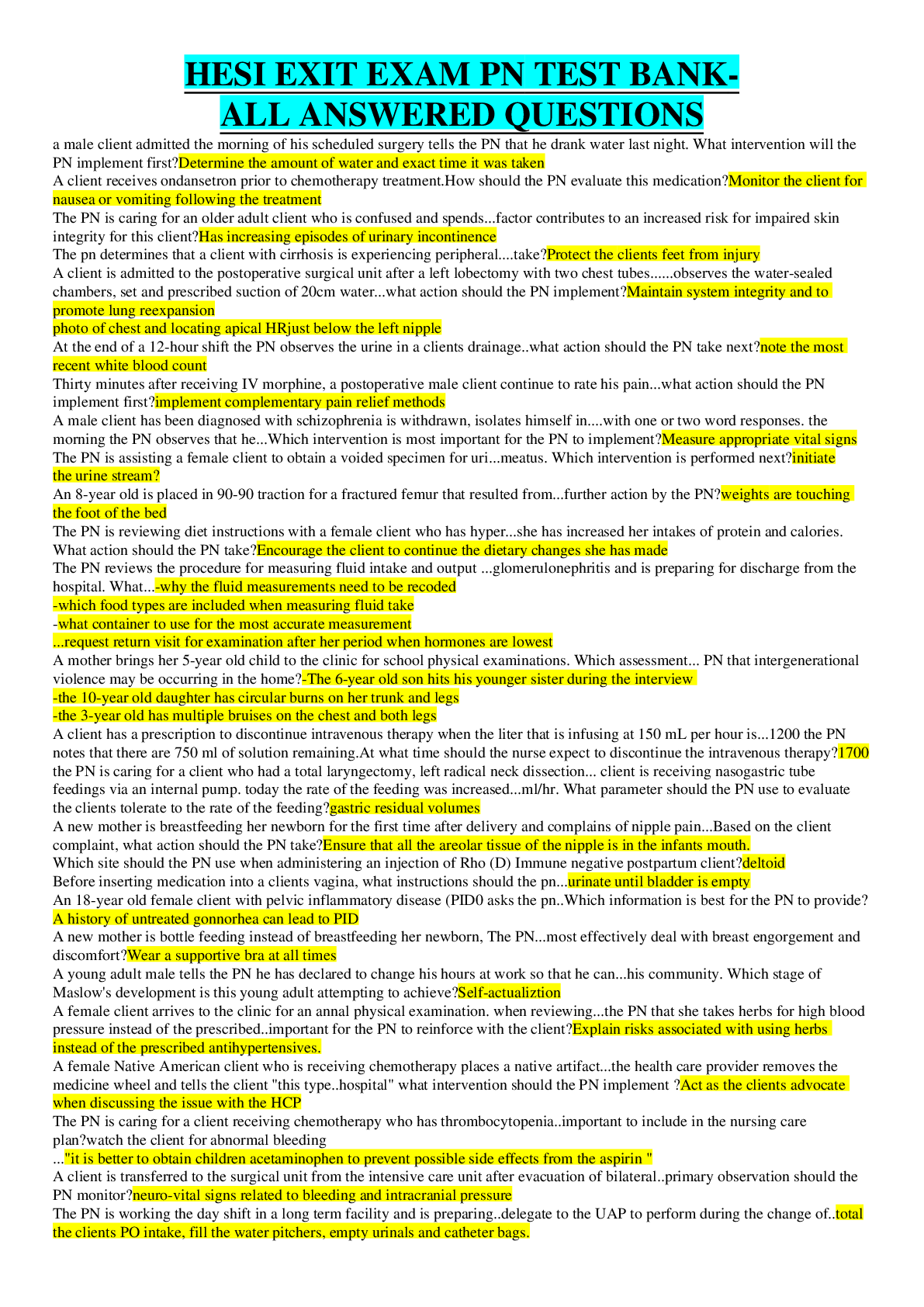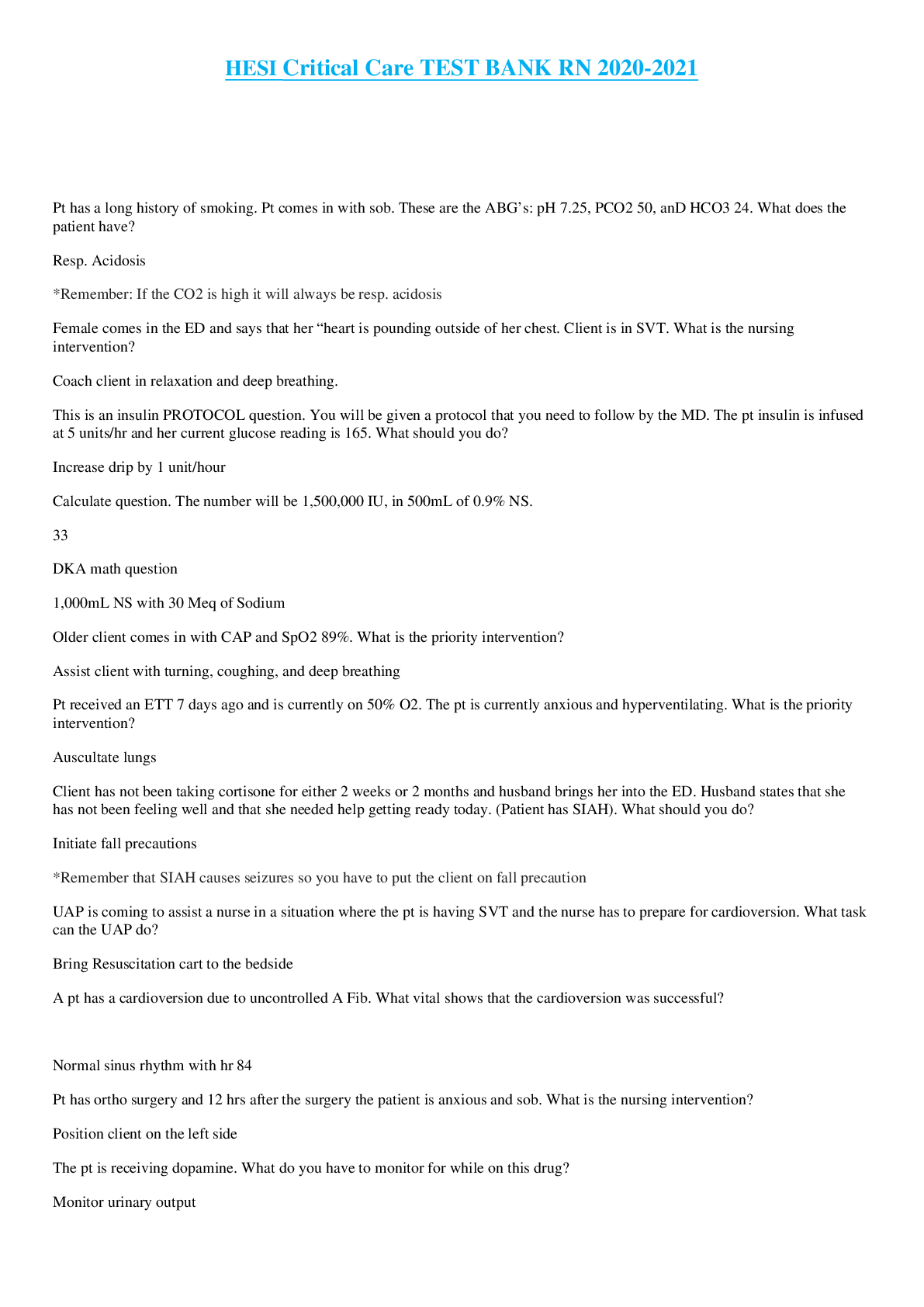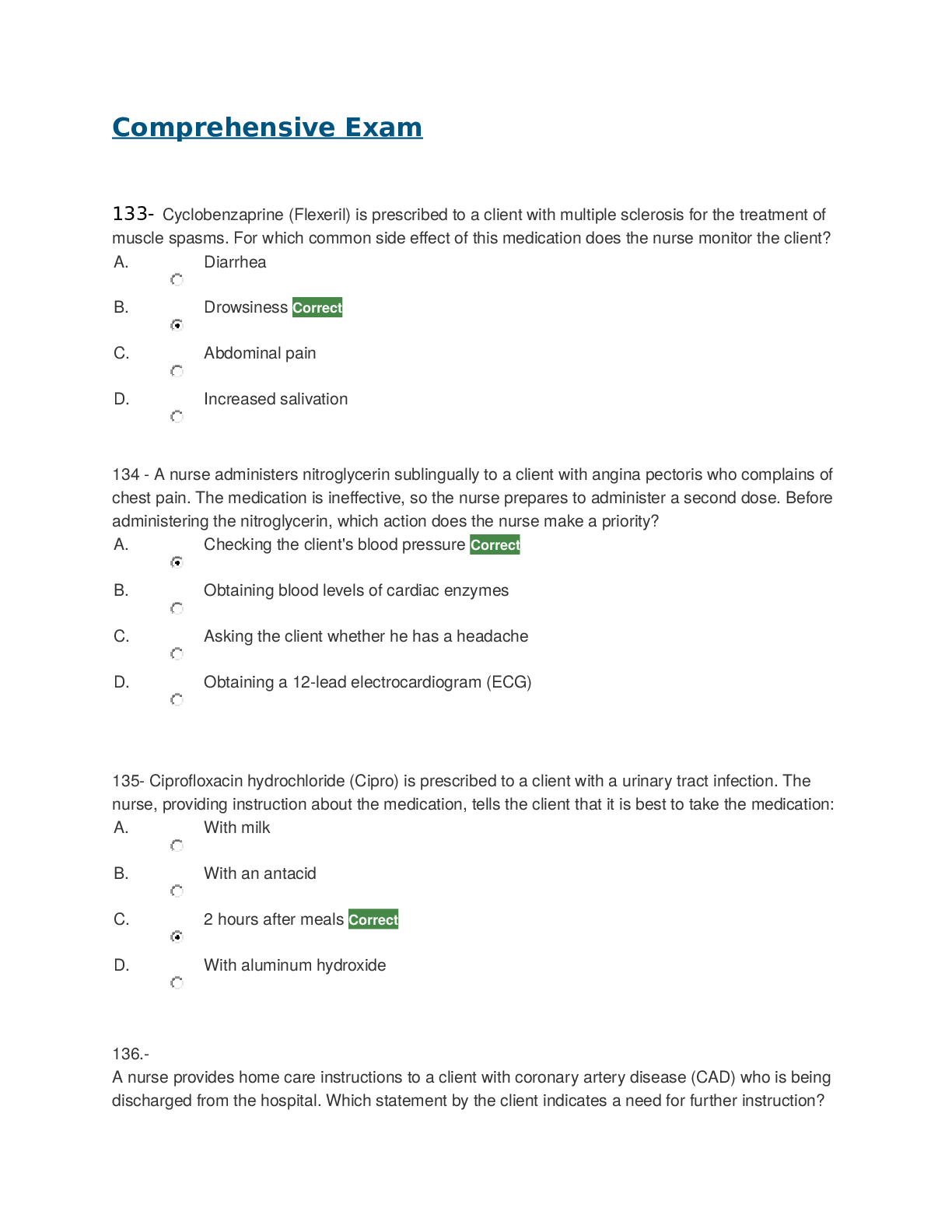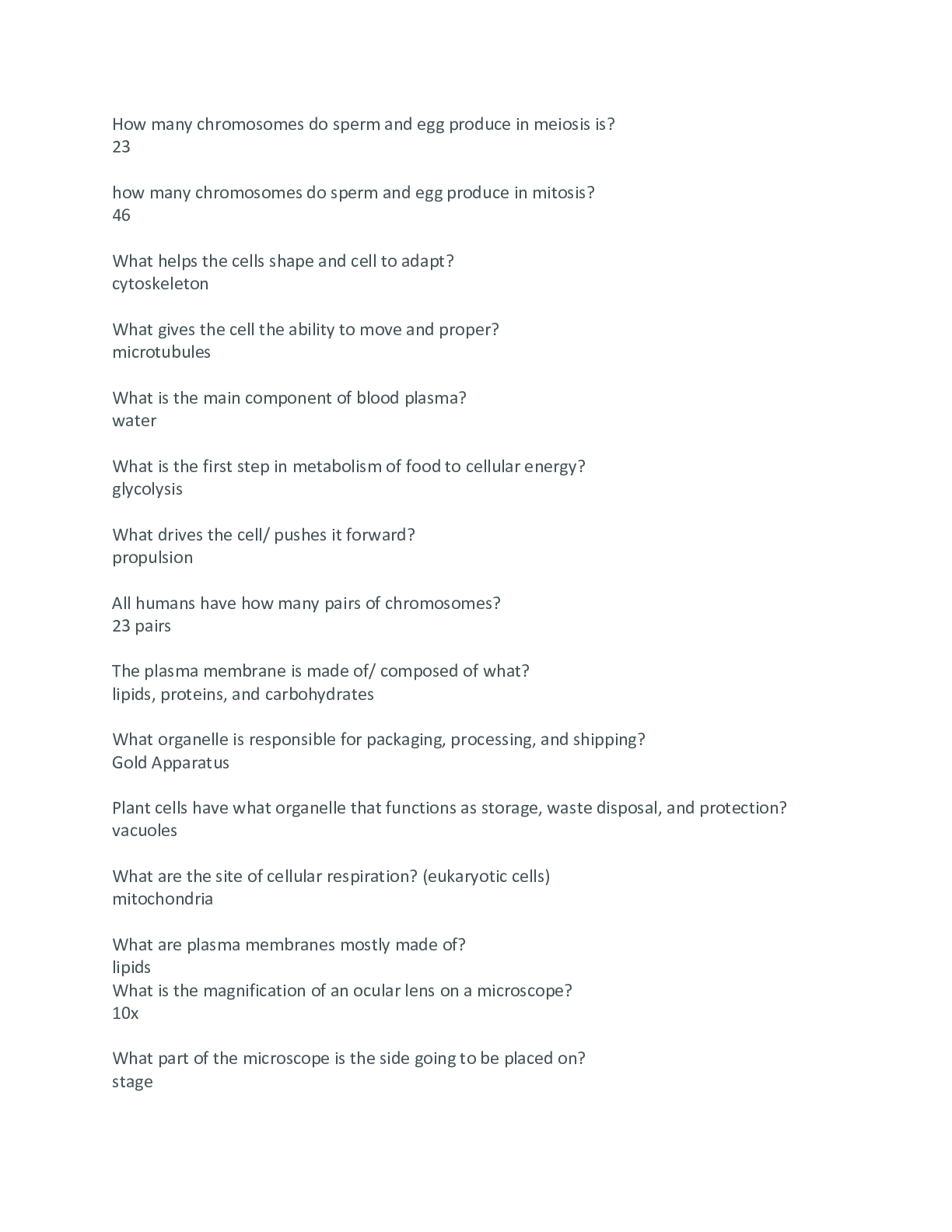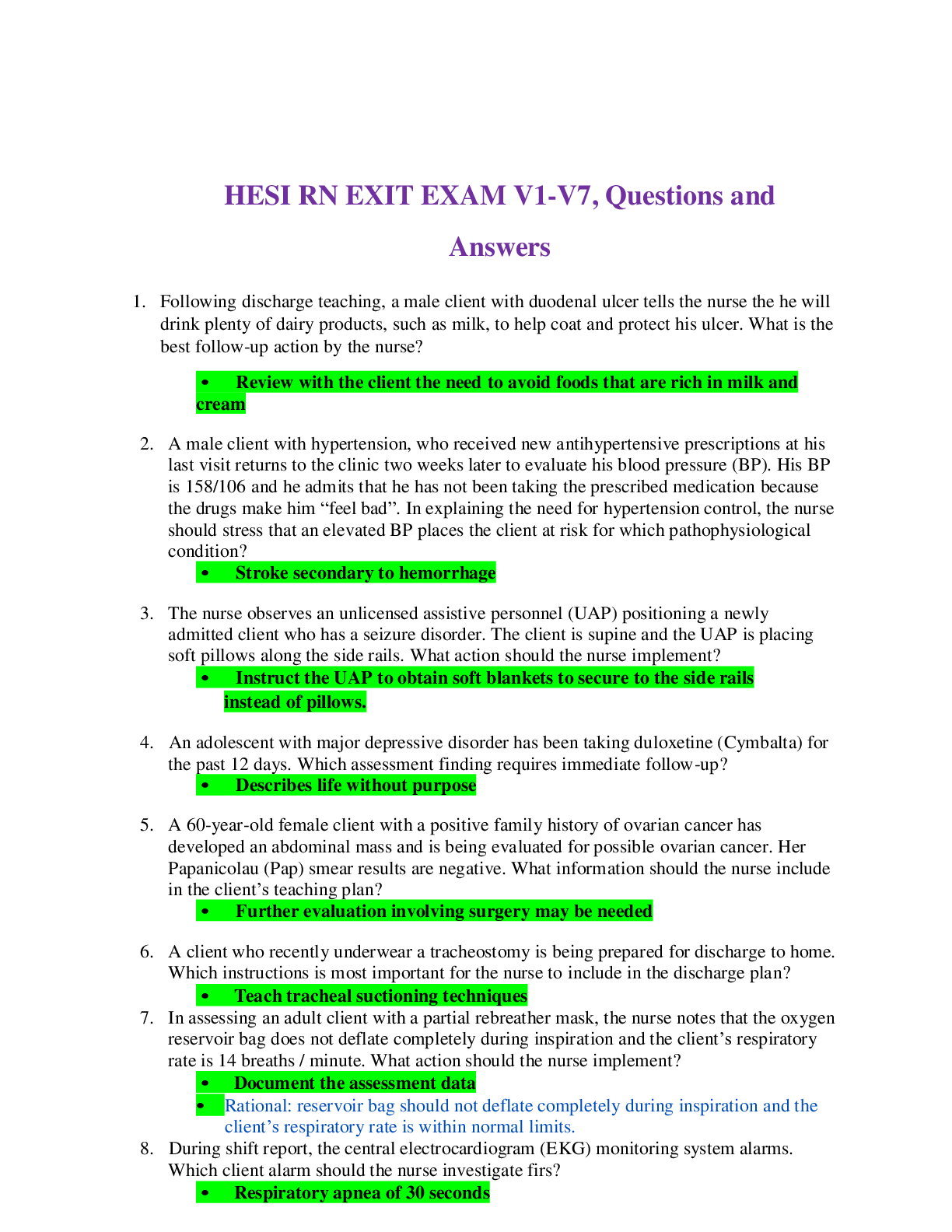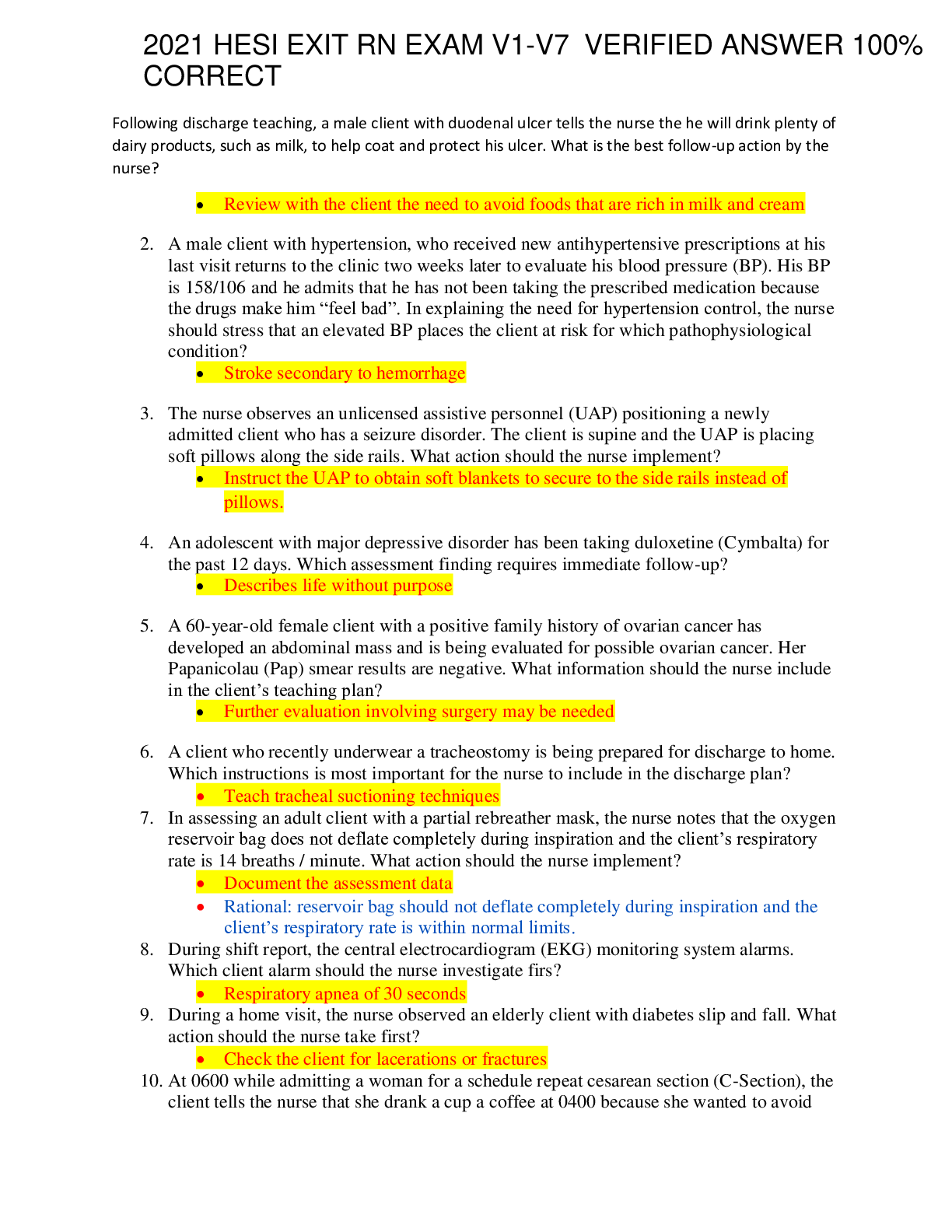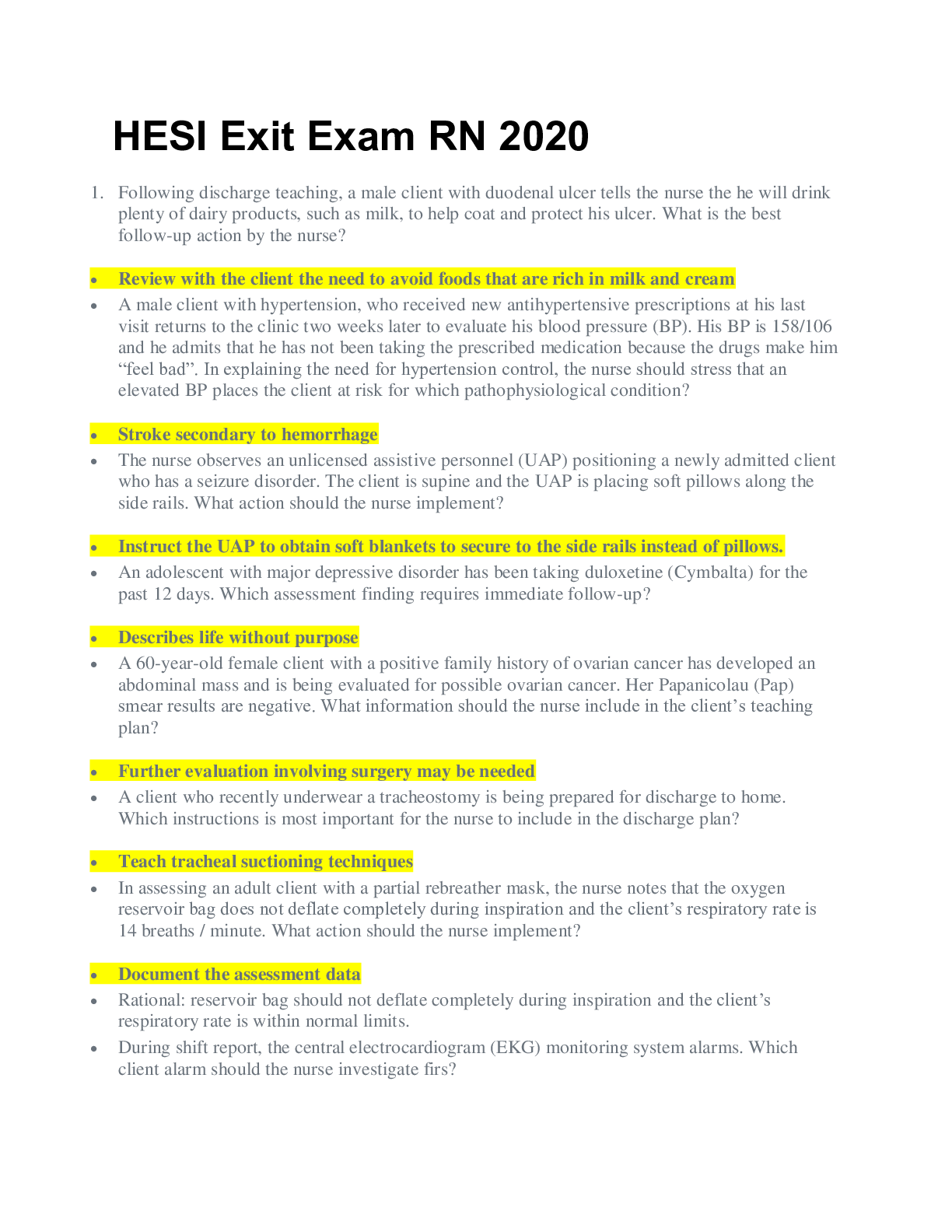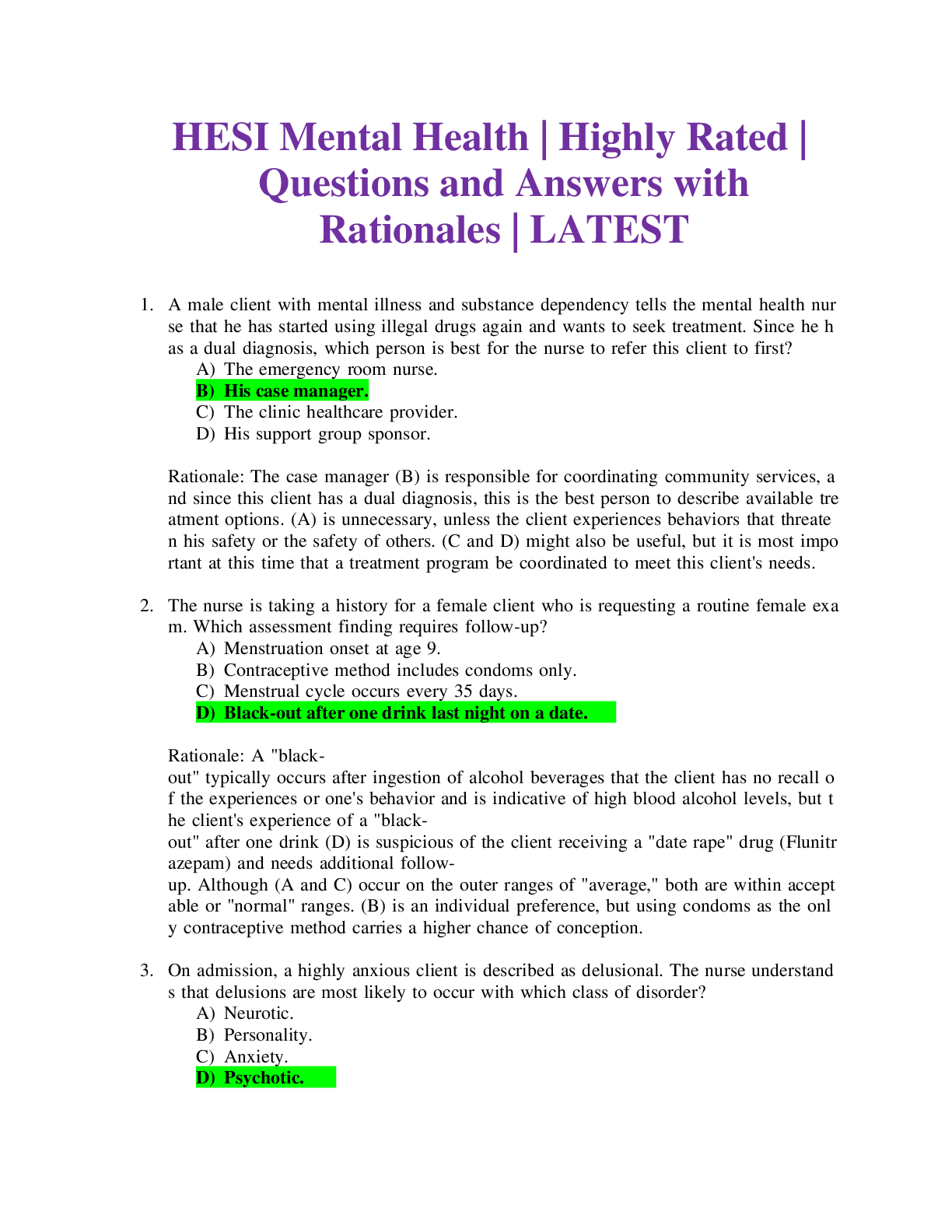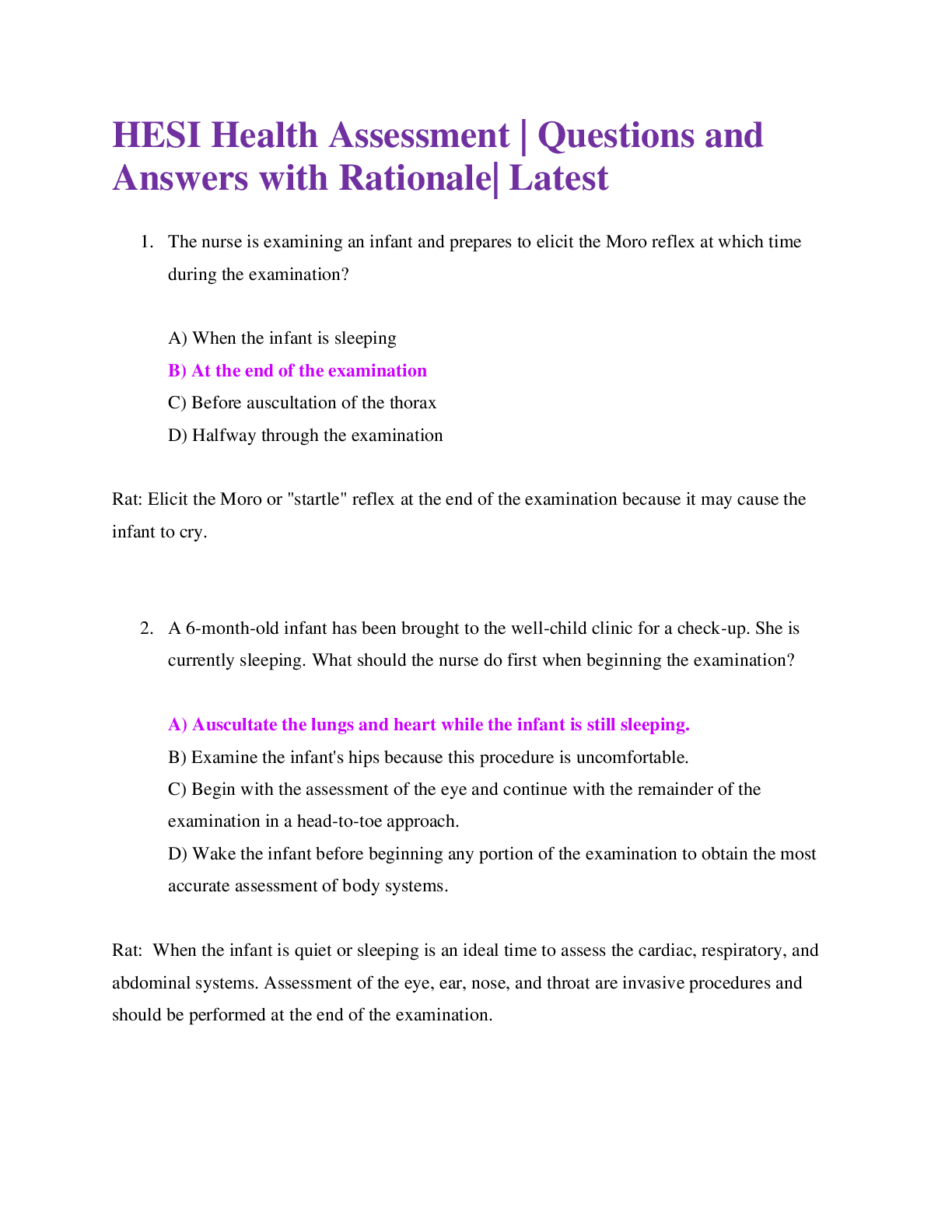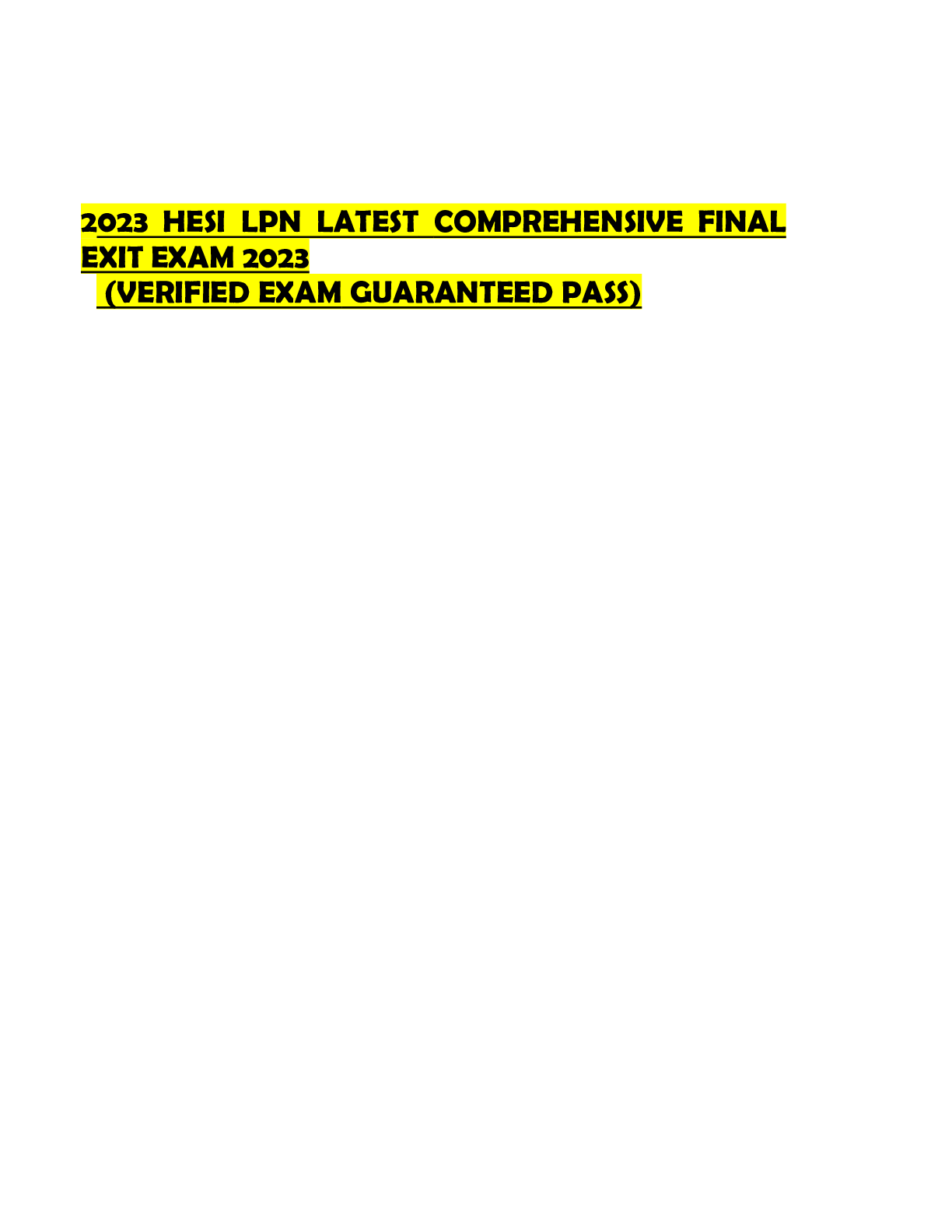Maternity (Practice) HESI latest update Graded A.
Document Content and Description Below
Maternity Practice HESI 7 year old diabetes I 6 month old introducing solid foods – should be introduced one at a time, every 4 to 7 days to determine food allergies Digoxin 3 month old with GHD,... miss a dose – if missed in less than 4 hours, gibe dose, if elapsed more than 4 hours, hold and give dose at next scheduled time 36 weeks pregnant, Rh-, bright red vaginal bleeding, nursing intervention rubella vaccine – instruction about use of a reliable method of birth control for 28 days after the rubella vaccine is given 6 years old, rheumatic fever, chorea 1 month old vomiting forcefully after each meal, is afebrile, dehydrated, and pyloric stenosis – olive shaped mass in the abdominal area that is evident at diaper change 18 weeks gestation, high AFP level – need for follow up evaluation with a sonogram to provide visual evidence of fetal age and presence of neural tube defects left breast mastitis, instruction to do at home magnesium sulfate, toxicity signs continuous fetal monitoring, V shaped appearance child with suspected bacterial meningitis, would have a recent history of unrelated bacterial upper respiratory, sinus, or ear infection - ear ache HIV+, receiving AZT during labor diaphragm size – after each birth the diaphragm should be evaluated for correct sizing and use an alternative form of contraception until verified Type I, 35 weeks gestation, amniocentesis Dilantin, newly diagnosed tonic – clonic epilepsy, seizure management – child should have routine serum levels monitored, as well as liver function infant with barking cough, fever, runny nose – croup, mother should the baby in the bathroom steamed up with hot water from tub or shower osteomyelitis foods to eat, 6 years old – high protein/high calories, milk shake is best choice 4 year old DMD symptoms – teach parents about these changes so they can prepare and help protect child from injuries pelvic inflammatory disease (PID) - IV antibiotics tonsillectomy, bleeding action – assess for bleeding with illumination to visualize oropharynx Ceftriaxone, + gonorrhea APGAR, 1/10, color is acrocyanotic young girl, UTI 9 year old, celiac disease, appendectomy, food to not eat – crackers = have gluten history of preeclampsia, high blood pressure what to use when changing newborn’s diaper – plain water 18 year old daughter, serum test results 38cm fundal height, 30 weeks gestation – after 20 weeks, the fundal height in cm should approximate # of weeks gestation 5 year old, bowel movement, yellow, sticky, smells like sour milk – typical for breastfed newborns, continue to breastfeed absence of testes on newborn admission assessment 3 month old does not sleep through the night 14 month old, hospitalized – febrile seizures 3 year old girl, blind since birth, hospitalized, compound fracture of the femur and is now in traction, intervention fundal massage technique – anchor the lower uterine segment with one hand, while massaging the fundus with the other hand, to prevent uterine prolapse and uterine inversion Maternity HESI 4. The nurse is teaching a client with gestational diabetes about nutrition and insulin need for pregnancy. Which content should the nurse include in this client’s teaching plan? A) Insulin production is decreased during pregnancy B) increase daily caloric intake is needed ? C) injection requirements remain the same D) Blood sugars need less monitoring in the first trimester 5. A 38-week primigravida client who is positive for Group A Beta Streptococcus receives a prescription for cefazolin 2 grams IV to be infused over 30 minutes. The medications available in 2 grams/100 ml of normal saline. The nurse should program the infusion pump to deliver how many ml/hour? 1.6ml/hr 7. When performing the daily head-to-toe assessment of a 1-day-old newborn, the nurse observes yellow tint to the skin on the forehead, sternum, and abdomen. What action should the nurse take? A) Measure bilirubin levels using transcutaneous bilirubinometry B) Review maternal medical records for blood type and Rh factor C) Prepare the newborn for phototherapy ? D) Evaluate cord blood Coomb’s test results 8. A new mother asks the nurse about an area of swelling on her baby’s head near the posterior fontanel that lies across the suture line. How should the nurse respond? A) “That is called caput succedaneum. It will absorb and cause no problems.” B) “That is called a cephalhematoma. It will cause no problems.” ? C) “That is called a cephalhematoma. It can cause jaundice as it is absorbed.” D) “That is called caput succedaneum. It will have to be drained.” 9.A 39-week-gestational multigravida is admitted to labor and delivery with spontaneous rupture of membranes (SROM) and contractions occurring every 2 to 3 minutes. A vaginal exam indicates that the cervix is dilated 6 cm, 90% effaced, and the fetus is at a +2 station. During the last 45 minutes the fetal heart rate (FHR) has ranged between 170 and 180 beats/minute. What action should the nurse implement? A) Obtain a blood specimen for hemoglobin B) Take an oral maternal temperature ? C) Straight catheterize the client D) Send amniotic fluid for analysis 10. An obviously pregnant woman walks into the hospital’s emergency department entrance, shouting, “Help me! Help me! My baby is coming! I’m so afraid!” The nurse determines if delivery is indeed imminent. What action is most important for the nurse to take? A) Determines the gestational age of the fetus B) Assess the amount and color of the amniotic fluid C) Obtain peripheral IV access and begin administration of IV fluids D) Provide clear, concise instructions in a calm, deliberate manner 11. During a routine prenatal health assessment for a client in her third trimester, the client reports that she had fluid leakage on her way to the appointment. Which technique should the nurse implement to evaluate the leakage? A) Palpate suprapubic area for fetal head position B) Insert straight urinary catheter to drain bladder C) Test the fluid with a nitrazine strip D) Scan the bladder for urinary retention 12. A client who is 3-weeks postpartum tells the nurse, “I am so tired all the time. I didn't know having a baby would be so hard.” What response should the nurse provide? A) It is common to feel exhausted for the first 3 months. Try to sleep when the baby sleeps. B) It is normal to feel tired for the first couple weeks. Be patient with yourself and rest more. C) You should not be doing any housework. Are any of your family members helping you? D) Adjusting to a new baby can be difficult. Tell me more about any help you are receiving. 13. The home health nurse visits a client who delivered a full term baby three days ago. The mother reports that the infant is waking up every 2 hours to bottle feed. The nurse notes white, curd-like patches on the newborn’s oral mucous membranes. What action should the nurse implement? A) Discuss the need for medication to treat curd-like oral patches B) Suggest switching the infant’s formula C) Assess the baby’s blood glucose level D) Remind mother not put the baby to bed with a propped bottles 16. Which action should the nurse take if an infant, who was born yesterday weighing 7.5 lbs (3,317 grams), weighs 7 lbs (3,175 grams) today. A) Monitor the stool and urine output of the neonate for the last 24 hours B) Inform and assure the mother that this is a normal weight loss C) Encourages the mother to increase frequency of breastfeeding. D) After verifying the accuracy of the weight, notify the healthcare provider. 17. A term multigravida, who is receiving oxytocin (Pitocin) for labor augmentation, is requesting pain medication. Review of the client’s record indication that she was medicated 30 minutes ago with butorphanol (Stadol) 2 mg and promethazine (Phenergan) 25 mg IV push. Vaginal examination reveals that the client’s cervical dilation is 3 cm, 70% effaced, and at a 0 station. What action should the nurse implement? A) Discontinue the Pitocin infusion B) Medicate the client with an additional 1 mg of Stadol IV push C) Notify the healthcare provider D) Instruct the client to use deep breathing during a contraction 18. A women who delivered a 9 pound baby boy by cesarean section under spinal anesthesia is recovering in the postanesthesia care unit. Her fundus is firm, at the umbilicus, and a continuous trickle of bright red blood with no clots from the vagina in observed by the nurse. Which action should the nurse implement? A) Massage the fundus vigorously B) Assess her blood pressure C) Apply ice pack to perineum D) Let the infant breast feed 21. When teaching a gravid client how to perform kick (fetal movement) counts, which instruction should the nurse include? A) Exercise for 15 minutes before starting the counting to help increase fetal movement B) Count the movements once daily, for one hour, before breakfast C) Avoid caffeinated drinks for 24 hours before conducting the kick test. D) If 10 kicks are not felt within one hour, drink orange juice and count for another hour. 23. A 26-week gestational primigravida who is carrying twins is seen in the clinic today. Her fundal height in measured at 29 cm. Based on these findings, what actions the nurse implement? A) Notify the healthcare provider of the finding B) Document the finding in the medical record C) Schedule the client for a biophysical profile D) Request another nurse measure the fundus 24. The nurse is performing a newborn assessment. Which symptoms, if present in newborn, would indicate respiratory distress? A) Abdominal breathing with synchronous chest movement B) Shallow and irregular respirations C) Flaring of the nares D) Respiratory rate of 50 breaths per minute 25. The nurse is caring for a laboring client who is GBS+ (Group B streptococcus). Which immediate treatment is indicated for this client? A) Administration of Pitocin B) Artificial rupture of the membranes C) Amnioinfusion for the baby D) Administration of antibiotics 26. The nurse examines a client who is admitted in active labor and determines the cervix is 3 cm dilated, 50% effaced, and the presenting part is at 0 station. An hour later, she tells the nurse that she wants to go to the bathroom. Which action should the nurse implement first? A) Check the pH of the vaginal fluid B) Review the fetal heart rate pattern C) Palpate the client’s bladder D) Determine cervical dilation ? 27. The nurse’s assessment of a preterm infant reveals decreased muscle tone, signs of respiratory difficulty, irritability, and mottled, cool skin. Which intervention should the nurse implement first? A) Position a radiant warmer over the crib B) Assess the infant’s blood glucose level C) Nipple feed 1 ounce 5% glucose in water D) Place the infant in a side-lying position 28. Which content should the nurse plan to include in a nutrition class for pregnant adolescents? (Select all that apply) A) Take iron and calcium supplements daily ? B) Gain no more than 15 pounds during the pregnancy C) Increase food intake by 300 to 400 calories/day ? D) Take folic acid supplements daily ? E) Maintain current protein intake ? 29. The healthcare provides prescribes 10 units/L of oxytocin (Pitocin) via IV drip to augment a clients labor because she is experiencing a prolonged active phase. Which finding would cause the nurse to immediately discontinue the oxytocin? A) uterus is soft B) contraction duration of 100 seconds C) four contractions in 10 minutes D) Early deceleration of fetal heart rate 30. A new mother who is breastfeeding her 4-week old infant and has type 1 diabetes, reports that her insulin needs have decreased since the birth of her child. What action should the nurse implement? A) Inform her that a decreased for insulin occurs while breastfeeding B) Advice the client to breastfeed more frequently C) Counsel her to increase her caloric intake D) Schedule an appointment for the client with diabetic nurse educator 31. A diabetic client delivers a full-term large-for-gestation-age (LGA) infant who is jittery. What action should the nurse take first? A) Administer oxygen B) Feed the infant glucose water (10%) C) Obtain a blood glucose level D) Decrease environmental stimuli 32. The postpartum admission prescription for a client who delivered a healthy newborn includes one liter of lactated ringers with oxytocin 20 units to infuse over 8 hours. How many milliunits /minute is the clients receiving? 33. A pregnant, homeless woman who has received no prenatal care presents to the clinic in her third trimester because she is having vaginal bleeding, but reports that she is not in pain. Ultrasound reveals a placenta previa. Which actions should the nurse implement? A) Schedule weekly prenatal appointments B) Contact social services for a temporary shelter C) Obtain a hemoglobin and hematocrit level D) Have the client transported to the hospital 34. The nurse is planning a class for pregnant women in the first trimester of pregnancy. Which information is most important for the nurse to include in the class? A) Plan rest periods and increase sleep time to 8 hours per day when fatigued B) If any vaginal bleeding occurs, notify the healthcare provider immediately C) Since eating often relieves nausea, carry low fat snacks to eat whenever nausea occurs D) If morning dizziness occurs, rise slowly and sit on the side of the bed for one minute 35. When assessing a pregnant woman at 39-weeks gestation who is admitted to labor and delivery, which finding is most important to report to the health care provider? A) +1 proteinuria B) 130/70 blood pressure C) +1 pedal edema D) 101.2 F oral temperature 36. A client who suspects she is pregnant tells the nurse she has a peptic ulcer that is being treated with misoprostol (Cytotec), a synthetic prostaglandin E drug. How should the nurse respond? A) “You may be at risk for having a spontaneous miscarriage” ? B) “You may have an increased chance of having preeclampsia” C) “This medication will have no effect on your unborn child” D) “You may experience postpartum hemorrhaging after delivery” 38. After delivery of a normal infant, the mother tells the nurses that she would like to use oral contraceptives. Which finding in the client’s health history is a contraindication of the use of contraceptives? A) Previously used an intrauterine device (IUD) B) Reported history of stroke within the family C) Diagnosed with diabetes mellitus 2 years ago D) Smoked cigarettes prior to becoming pregnant ? 39. When planning care for a laboring client, the nurse identifies the need to withhold solid foods while the client is in labor. What is the most important reasons for this nursing intervention? A) Nausea occurs from analgesics used during labor B) Autonomic nervous system stimulation during labor decreases peristalsis C) An increased risk of aspiration can occur if general anesthesia is needed D) Gastric emptying time decreases during labor. 40. The parents of a male newborn have signed an informed consent for circumcision. Which intervention should the nurse implement upon completion of the circumcision? A) Place petroleum gauze dressings on the site ? B) wrap the infant in warm receiving blankets C) Give a PRN dose of liquid acetaminophen D) Offer a pacifier dipped in glucose water 42. At 6 weeks gestation, the rubella titer of a client medication indicates she is non-immune. When is the best time to administer a rubella vaccine to this client? A) After the client stops breastfeeding B) Immediately, at 6-weeks gestation, to protect this fetus C) After the client reaches 20-weeks gestation D) Early postpartum, within 72 hours of delivery 44. A woman in her third trimester of pregnancy has been in active labor for the past 8 hours and cervix dialed 3 cm. The nurse’s assessment findings and electronic fetal monitoring (EFM) are consistent with hypotonic dystocia, and the healthcare provider prescribes an oxytocin (Pitocin) drip. Which data is most important for the nurse to monitor? A) Client’s hourly blood pressure B) Preparation for emergency cesarean birth C) Intensity, interval, and length of contractions D) Checking the perineum for bulging 45. The nurse is caring for a newborn who is 18 inches long, weighs 4 pounds, 14 ounces, has a head circumference of 13 inches, and a chest circumference of 10 inches. Based on these physical findings, assessment for which condition has the highest priority? A) Hyperthermia B) Hyperbilirubinemia C) Polycthemia D) Hypoglycemia 47. A client who is anovulatory and has hyperprolactinemia is being treated for infertility with metformin (Glucophage), menotropins (Repronex, Menopur), and human chorionic gonadotropin (hCG). Which side effects should the nurse tell the client to report immediately? A) Episodes of headache and irritability B) Nausea and vomiting C) Rapid increase in abdominal girth D) Persistent daytime fatigue M 48. At 0600 while admitting a woman for a scheduled repeat caesarean section (C-section), the client tells the nurse that she drank a cup of coffee at 0400 because she wanted to avoid getting a headache. Which action should the nurse take first? A) Contact the client’s obstetricianaz B) Ensure preoperative lab results are available C) Inform the anesthesia care provider D) Start prescribed IV with Lactated Ringer’s 49. Following the vaginal delivery of a 10-pound infant, the nurse assesses a new mother’s vaginal bleeding and finds that she has saturated two pads in 30 minutes and has a boggy uterus. What action should the nurse implement first? A) Have the client empty her bladder ? B) Inspect the perineum for lacerations C) Increase oxytocin (Pitocin) IV infusion D) Perform fundal massage until firm 51. A 33-year-old client at 9 weeks gestation tells the nurse that while she has “cut down,” she still has at least one alcoholic drink every evening before bedtime. What intervention should the nurse implement? A) Notify child protective services of the client’s illicit drug use and probable child endangerment B) Praise the client for her actions and offer to discuss ways to decrease consumption even more C) Insist that the client stop all alcohol use and draw a blood alcohol level at each prenatal visit ? D) Refer the client to an outpatient alcohol abuse program for disulfiram (Antabuse) therapy 8. When evaluating the effectiveness of a client’s nursing care, the nurse first reviews the expected outcomes identified in the plan of care. What action should the nurse take next? A) Modify the nursing interventions to achieve the clients goals. B) Determine if the expected outcomes were realistic. C) Review related professional standards of care. D) Obtain current client data to compare with expected outcomes. A male client has right-sided hemiplegia following a left cerebrovascular accident (CVA). His sitting balance has improved, and he is now able to sit In a wheelchair. To assist the client in transferring from the bed to a wheelchair, what action should the nurse take? A) Have the client put both arms around the nurse’s neck for support. B) Place the wheelchair on the client’s left side. C) Instruct the client to look at his feet. D) Instruct the client total slow, deep breaths while transferring. A 16-year-old gravida 1, para 0 client has just been admitted to the hospital with a diagnosis of eclampsia. She is not presently convulsing. Which intervention should the nurse plan to include in this client’s nursing care plan? A) Keep an airway at the bedside B) Assess temperature every hour C) Monitor blood pressure, pulse, and respirations every 4 hours ? D) Allow liberal family visitation The 2-hour exam a newborn delivered by cesarean section reveals nasal flaring, visible retractions, audible grunting, and a dusky skin color. Current vital signs are: axillary temp 98.5 F, pulse 148 beats/minute, and respiration 67 breaths/minute. Which intervention should the nurse implement first? A) Determine the infant’s blood glucose level B) Delay giving the infants initial bath for one hour C) Notify the healthcare provider of the infants current status ? D) Place a pulse oximeter on the infants foot A primipara client at 42-weeks gestation is admitted for induction. Within one hour after initiating an oxytocin (Pitocin) infusion, her cervix is 100% effaced and 6cm dilated, contractions are occurring every 1 minute with a 75 second duration. The nurse stops the Pitocin and starts oxygen. After 30 minutes of uterine rest, the contractions are occurring every 5 minutes with a 20 second duration. Which intervention should the nurse implement? A) Stop oxygen per canula B) Check for clonus in both feet C) Notify nursery about the clients response ? D) Restart Pitocin infusion rate per protocol A client at 32-weeks gestation presents with extreme abdominal tenderness and a small amount of bright red vaginal bleeding. Her blood pressure is 95/65, respiratory rate is 24 breaths/minute, and her heart rate is 116 beats/minute. She is dizzy, with cold, clammy skin. Which prescription has the highest priority? A) Type and cross-match for 4 units of whole blood B) Insert a foley catheter C) Lactated Ringers at 200ml/hr using an 18 gauge needle D) Monitor oxygen saturation rate per pulse oximeter ? Following a precipitous labor, a postpartum client has a continuous trickling of bright red blood from her vagina. Her uterus is firming, her vital signs are within normal limits. The nurse determines that this sign may indicate which condition? A) Expected course in fourth stage of labor B) Early postpartum hemorrhage C) A full urinary bladder ? D) Laceration on the cervix At 20-weeks gestation, a client who has gained 20 pounds during this pregnancy tells the nurse that she is feeling fetal movement. Fundal height measurement is 20 cm, and the client’s only complaint is that her breasts are leaking clear fluid. Which assessment finding warrants further evaluation? A Presence of fetal movement B Gestational weight gain C Fundal height measurement D Leakage from breasts A client at 40-weeks gestation presents to the obstetrical floor and indicates that the amniotic membranes ruptured spontaneously at home. She is in active labor, and feels the need to bear down and push. What information is most important for the nurse to obtain first? A Estimated amount of fluid B Any odor noted when membranes ruptured C Color and consistency of fluid D Time the membranes ruptured An infant with tetralogy of Fallot becomes acutely cyanotic and hyperpneic. What action should the nurse implement first? A Place the infant in a knee-chest position B Administer morphine sulfate C Start intravenous fluids D Provide 100% oxygen by face mask A one-day-old neonate develops a cephalhematoma. The nurse should closely assess this neonate for which common complication? A Jaundice B Poor appetite C Brain damage D Hypoglycemia The nurse is reviewing the serum laboratory finding for a 5-day-old infant with congenital adrenal hyperplasia. Which laboratory results should be reported to the healthcare provider immediately? A Bilirubin of 1.5 mg/dL B Glucose of 80 mg/dL C Potassium of 4.5 mEq/L D Sodium of 119 mEq/L A breastfeeding infant, screened for congenital hypothyroidism, is found to have low levels of thyroxine (T4), and high levels of thyroid stimulating hormone (TSH). What is the best explanation for this finding? A The thyroxine level is low because the TSH level is high B High thyroxine levels normally occur in breastfeeding infants C The thyroid gland does not produce normal levels of thyroxine for several weeks after birth D The TSH is high because of the low production of T4 by the thyroid A primigravida arrives at the observation unit of the maternity unit because thinks is in labor. The nurse applies the external fetal heart monitor and determines that the fetal heart rate is 140 beats/minute and the contractions are occurring irregularly every 10 to 15 minutes. What assessment finding confirms to the nurse that the client is not labor at this time? D. Contractions decrease with walking. The nurse is assessing a 2-hour-old infant born by cesarean delivery at 39-weeks gestation. Which assessment finding should receive the highest priority when planning the infant’s care? A Blood pressure 76/42 B Faint heart murmur C Respiratory rate 76 breaths/minute D Blood glucose 45 mg/dL The parents of a newborn tell the nurse that their baby is already trying to walk. How should the nurse respond? A Encourage the parents to report this to the healthcare provider B Acknowledge the parents’ observation C Schedule the newborn for further neurological testing D Explain the newborn’s normal stepping reflex During the admission procedure of a 6-year-old, the child states, “I’m going to have an operation.” Which response is best for the nurse to provide this child? A Are you scared? B We’re going to do everything we can to take very good care of you. C Tell me what an operation is. D I’m glad your mother told you why you were coming to the hospital. ? One day after vaginal delivery of a full-term baby, a postpartum client’s white blood cell count is 15,000/mm^3. What action should the nurse take first? A Check the differential, since the WBC is normal for this client B Assess the client’s temperature, pulse, and respirations q4h C Notify the healthcare provider, since this finding is indicative of infection D Assess the client’s perineal area for signs of a perineal hematoma The mother of a preschool-age child calls the school nurse to report that her child was bitten by a tick while on a school outing last week. The mother tells the nurse that she removed the tick and flushed it down the toilet. What action should the nurse take? A Refer the mother to the center for disease control B Report the incident to the school principal C Culture the site when the child returns to school D Schedule a test for Lyme disease if a rash appears Albumin 25% IV is prescribed for a child with nephrotic syndrome. Which assessment finding indicates to the nurse that the medication is having the desired effect? A Weight gain B Reduction of fever C Improved caloric intake D Reduction of edema The nurse is conducting postpartum teaching with a mother who is breastfeeding her infant. When discussing birth control, which method should the nurse recommend to this client as best for her to use in preventing an unwanted pregnancy? A Breastfeed exclusively at least every 3 to 4 hours B Condoms and contraceptive foam or gel C Rhythm method (natural family planning) D Combined estrogen-progesterone oral contraceptives ?? A full-term, 24-hour-old infant in the nursery regurgitates and suddenly turns cyanotic. What should the nurse do first? D. Stimulate the infant to cry. A community health nurse visits a family in which a 16-year-old unmarried daughter is pregnant with her first child and is at 32-weeks gestation. The client tells the nurse that she has been having intermittent back pain since the night before. What is the priority nursing intervention? A Ask the client’s mother to call an ambulance for transport to the hospital immediately B Determine what physical activities the client has performed for the past 24 hours C Teach the client how to perform pelvic rock exercises and observe for correct feedback ? D Ask the client if she has experienced any recent changes in vaginal discharge A young girl with a fractured radius has a cast applied. As the cast is drying, it is elevated above the level of her heart. Which assessment finding should the nurse report to the healthcare provider immediately? A Itching sensation under the cast B Swelling of fingers with brisk capillary refill C Numbness and inability to move fingers D Visible bruising above the cast At 39-weeks gestation, a multigravida is having a nonstress test (NST). The fetal heart rate (FHR) has remained non-reactive during 30 minutes of evaluation. Based on this finding, which action should the nurse implement? A Initiate an intravenous infusion B Observe the fetal heart rate pattern for 30 more minutes C Schedule a biophysical profile D Place an acoustic stimulator on the abdomen [Show More]
Last updated: 1 year ago
Preview 1 out of 50 pages
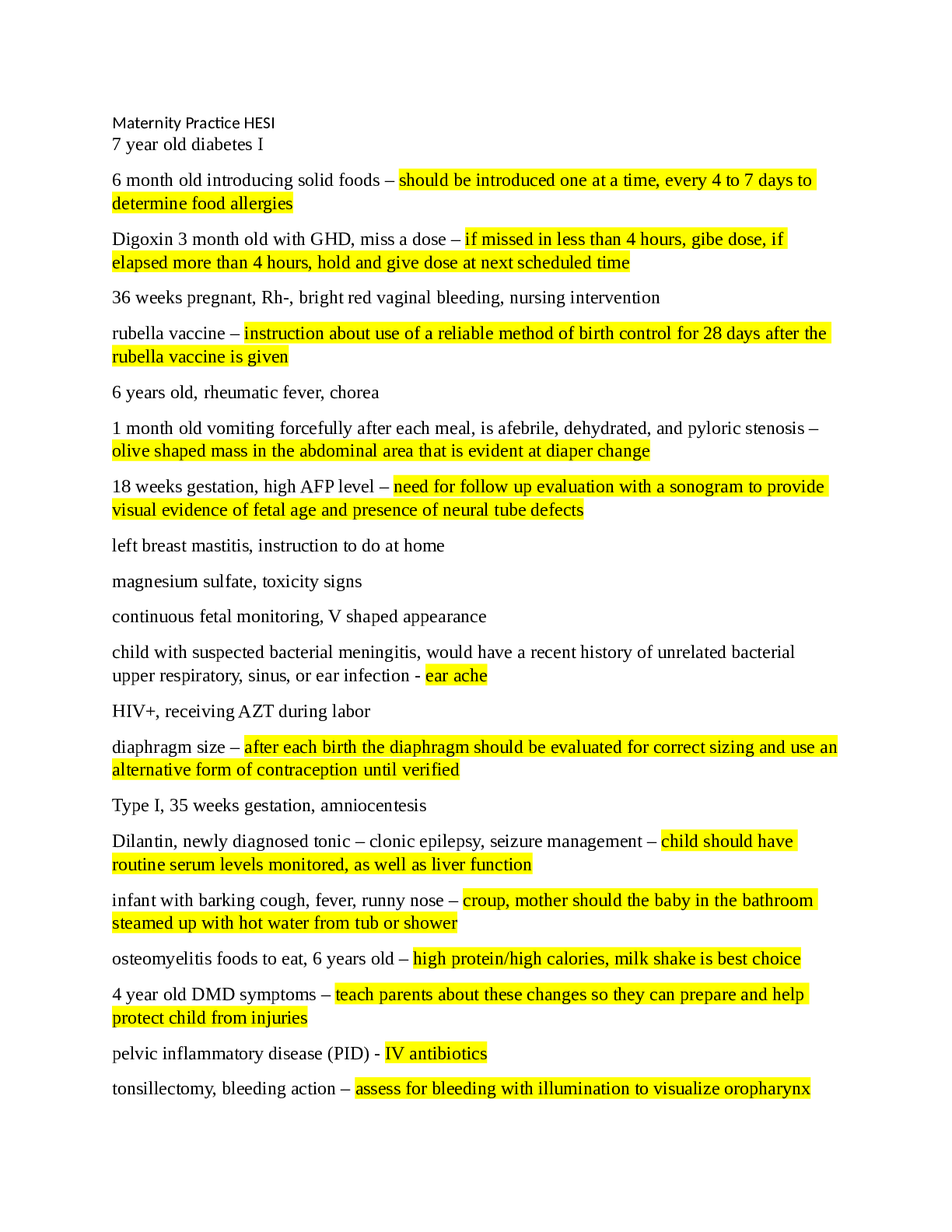
Reviews( 0 )
Document information
Connected school, study & course
About the document
Uploaded On
Jan 21, 2021
Number of pages
50
Written in
Additional information
This document has been written for:
Uploaded
Jan 21, 2021
Downloads
0
Views
70


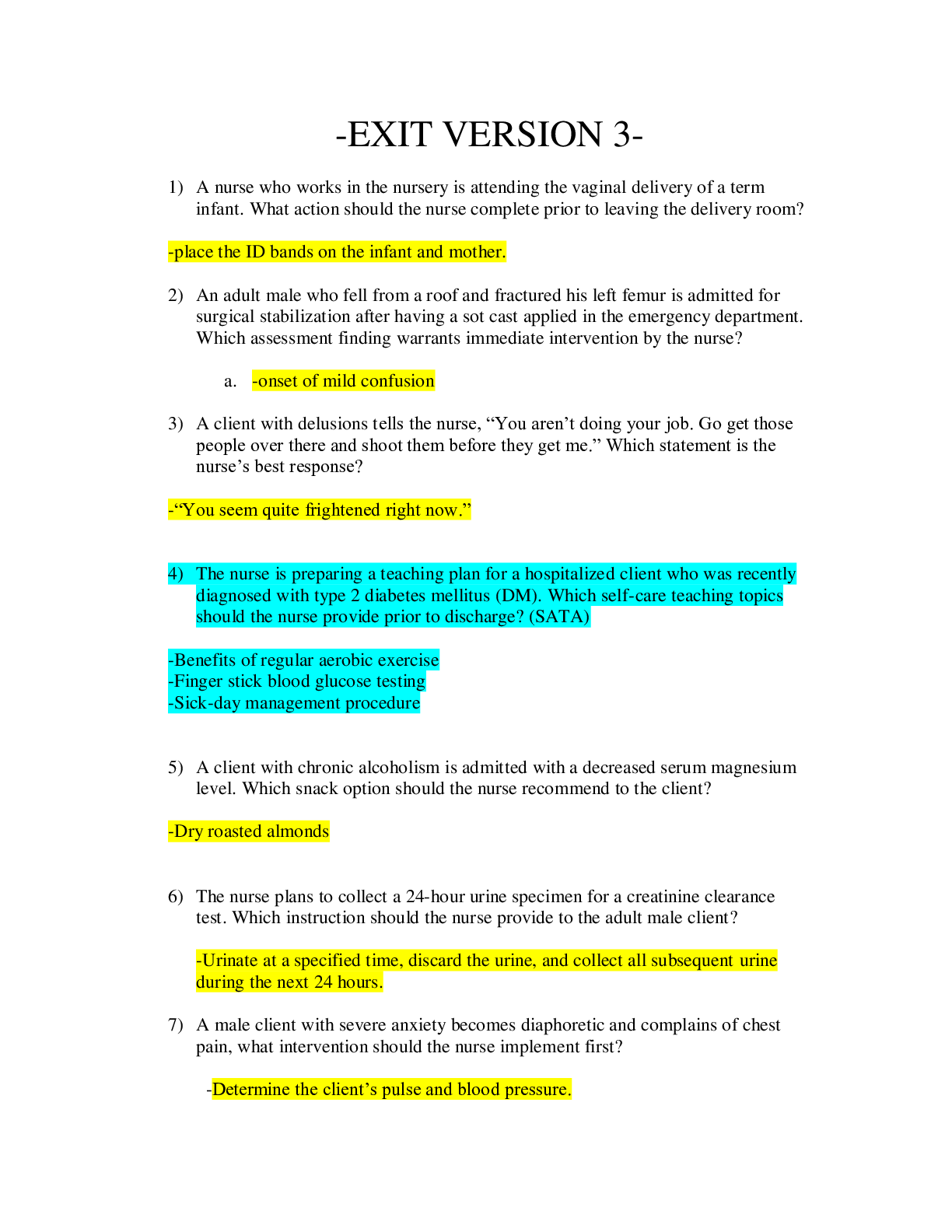

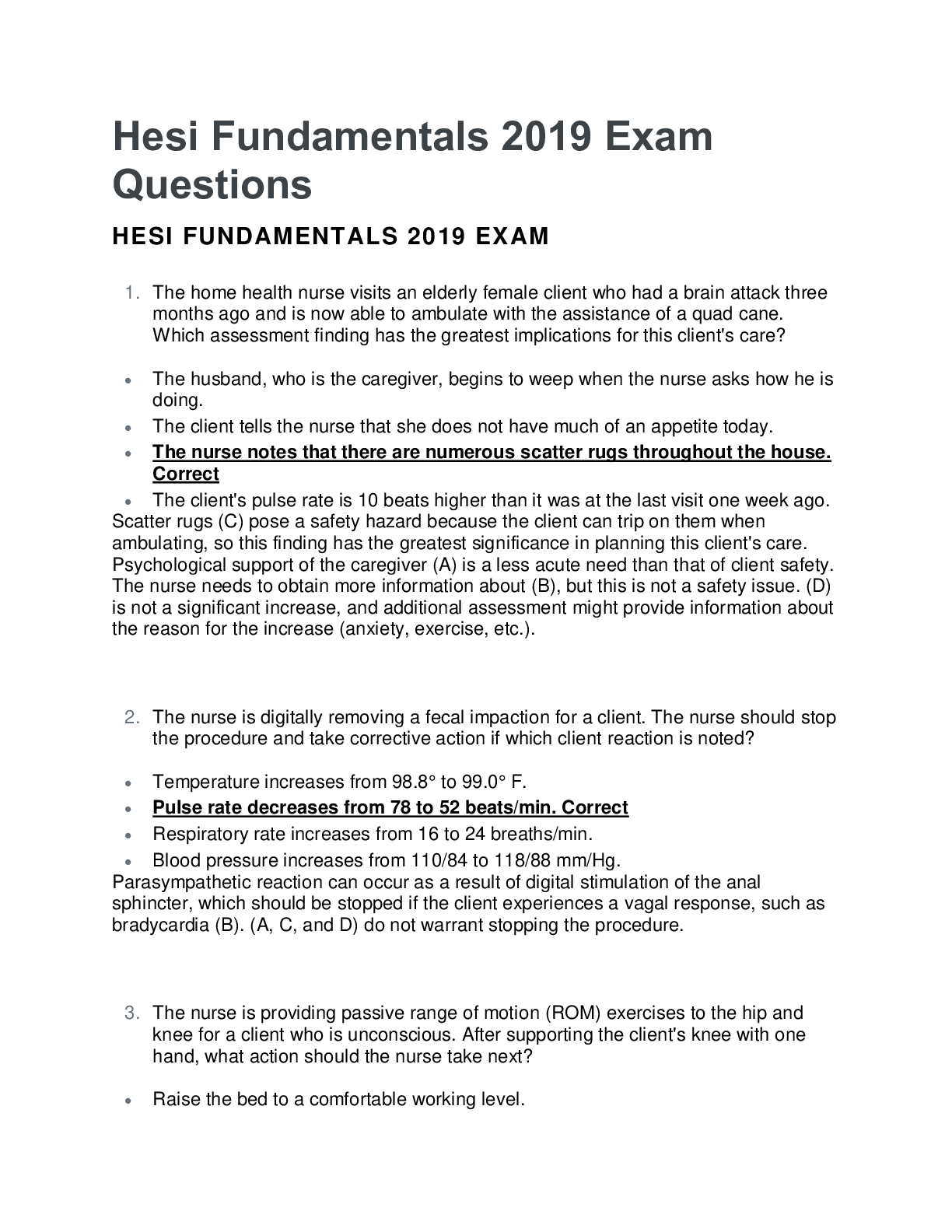

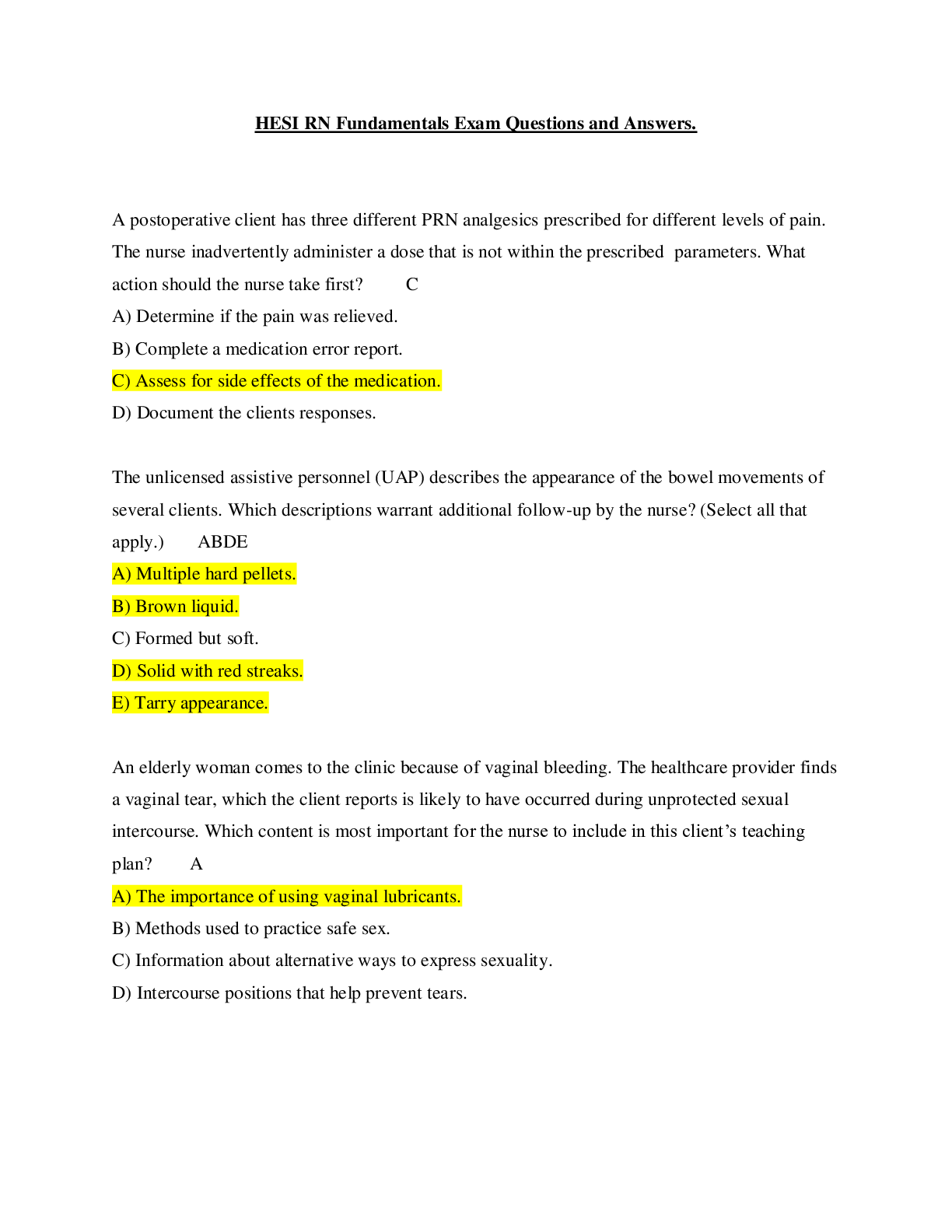

.png)
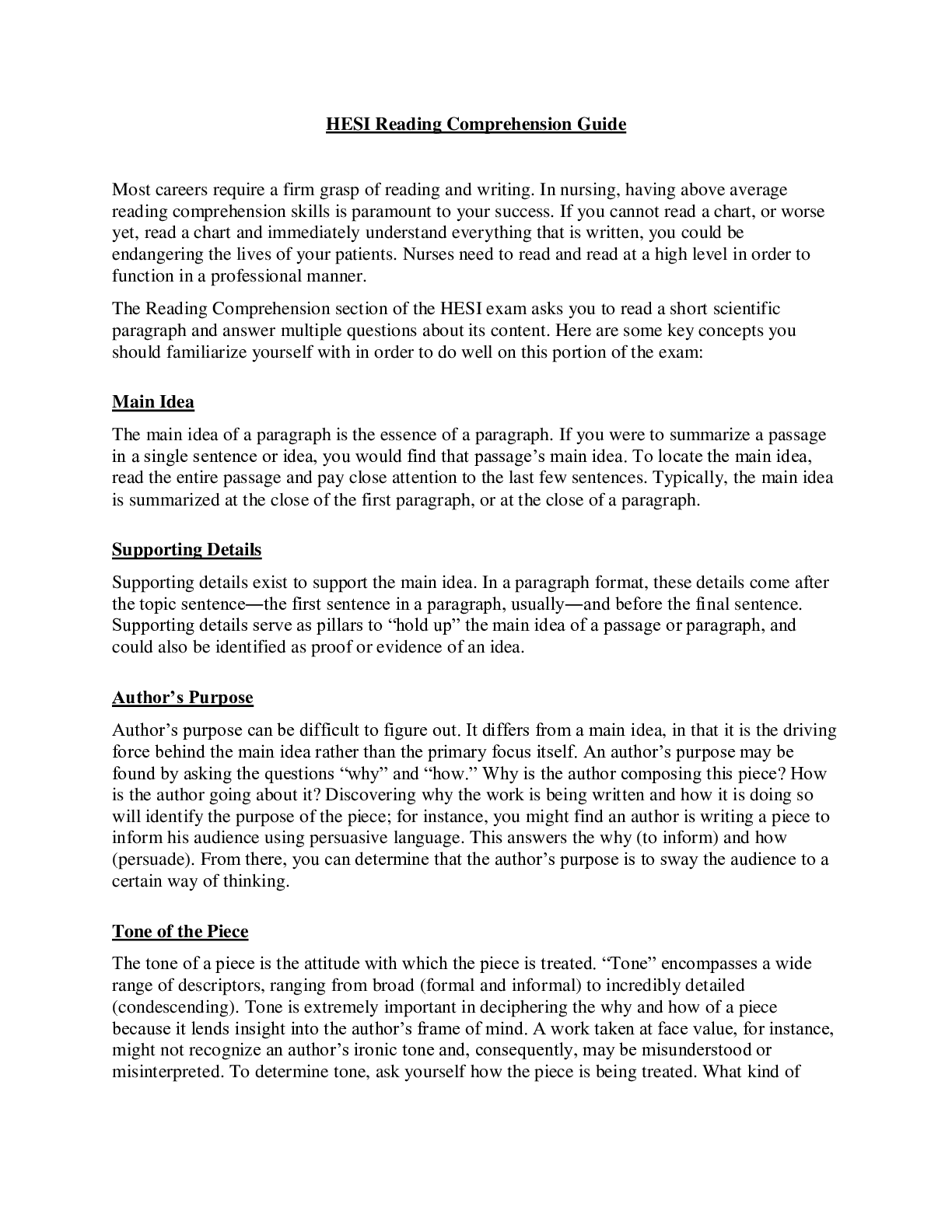
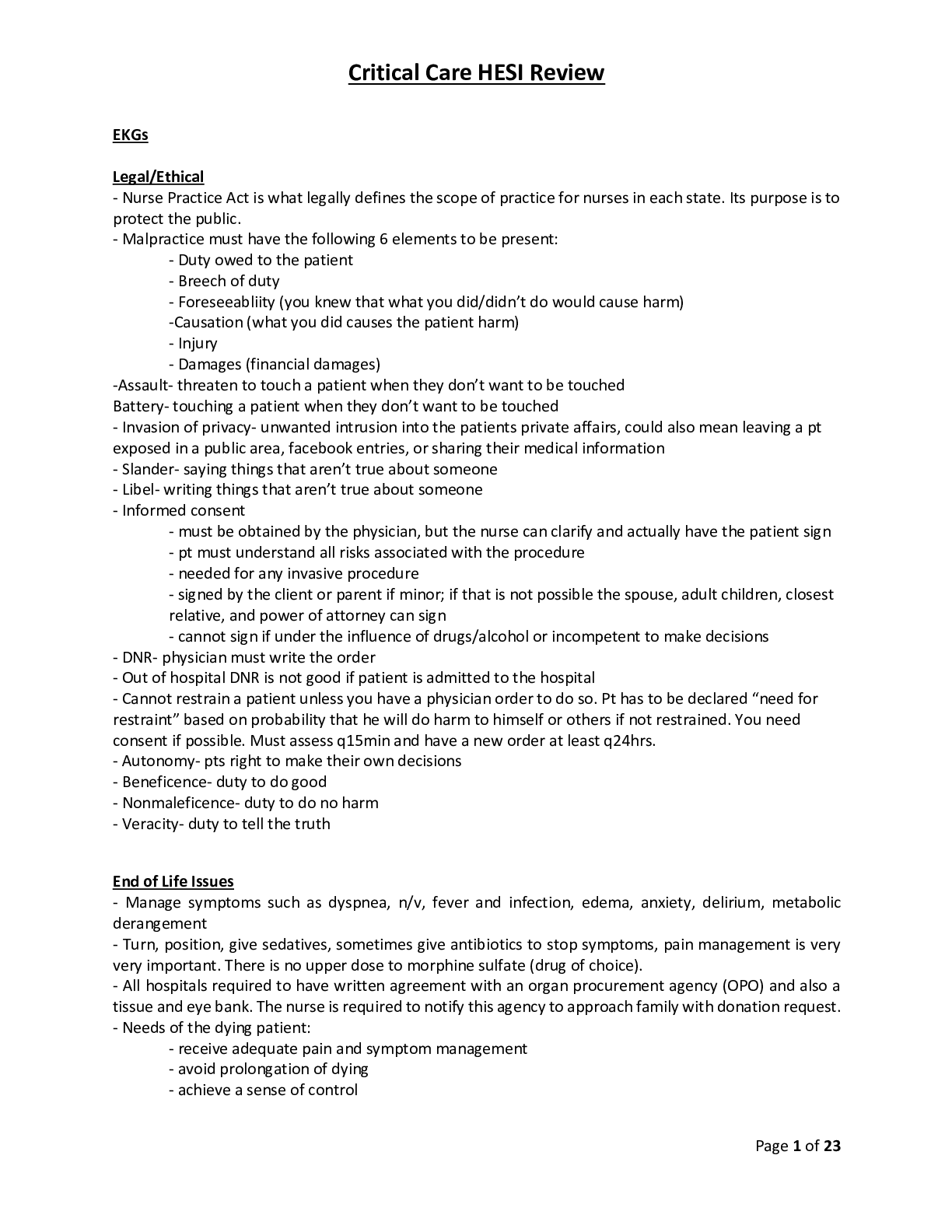
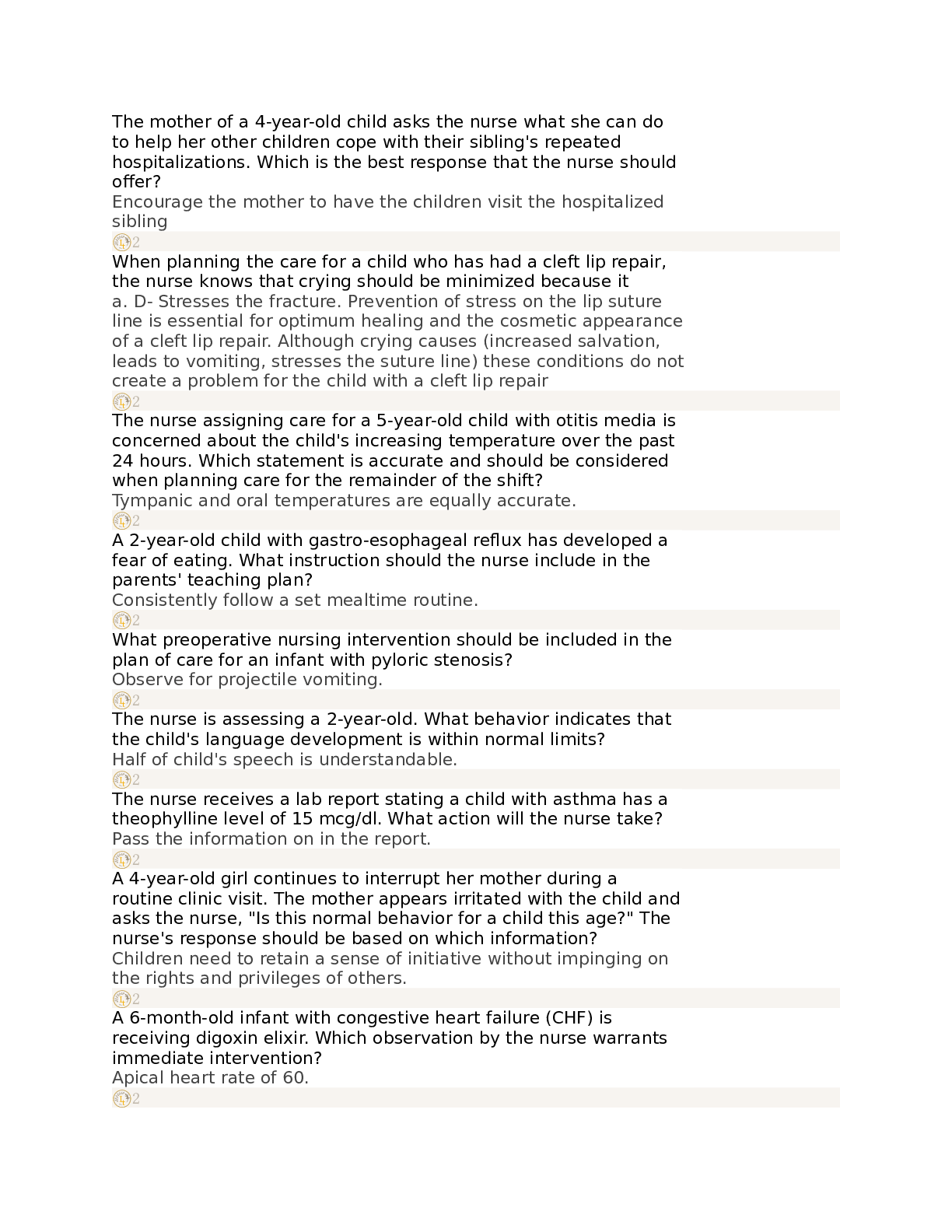
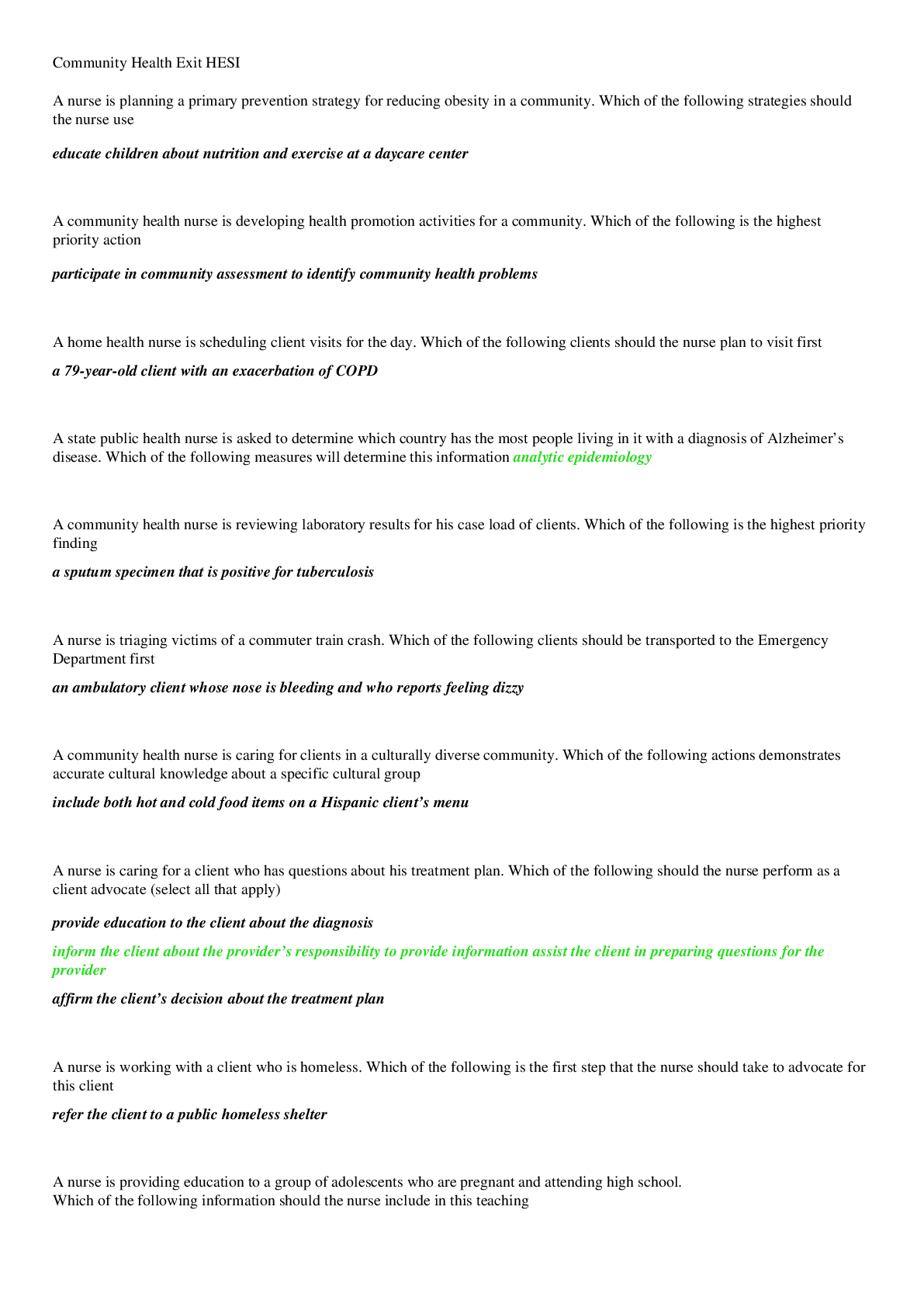
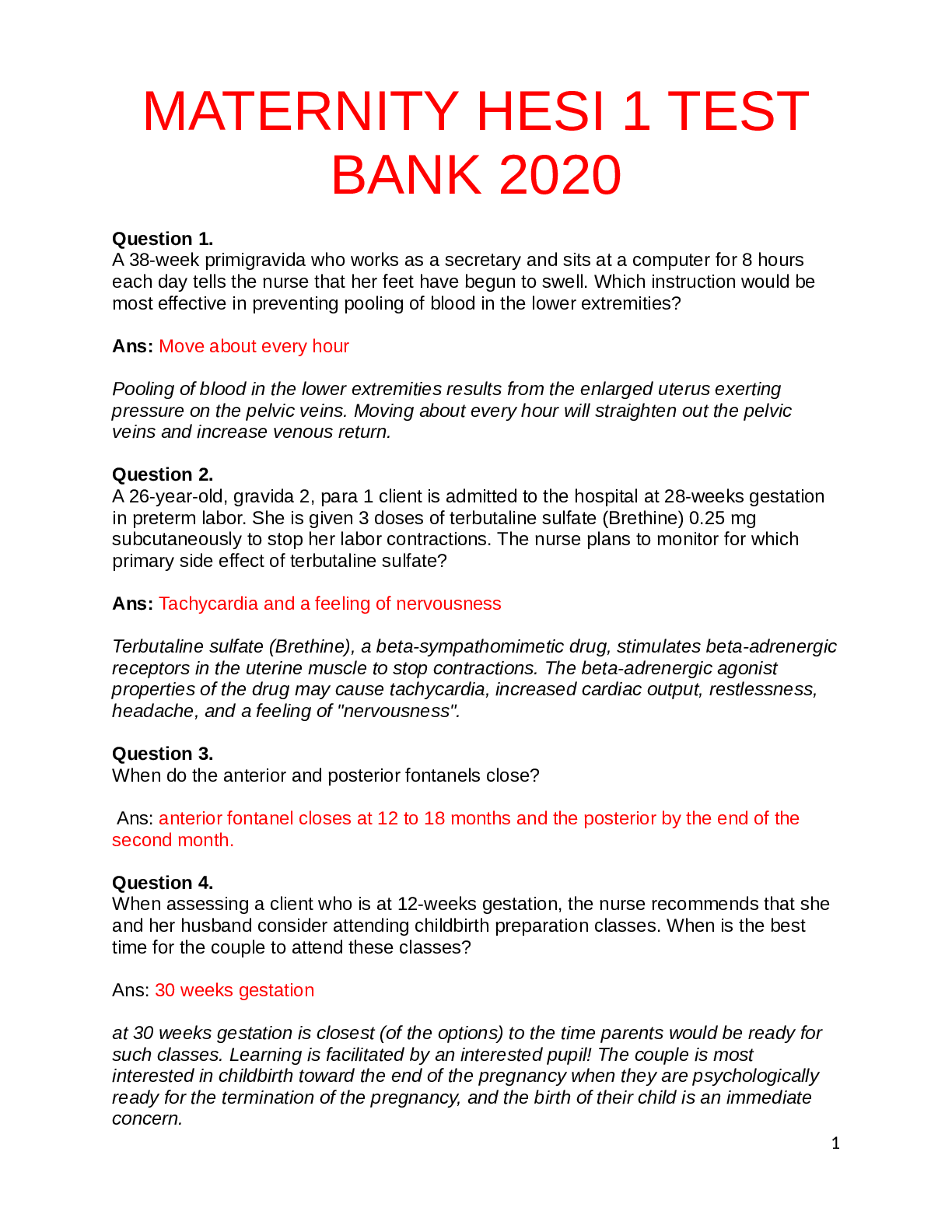

.png)




 (1).png)



